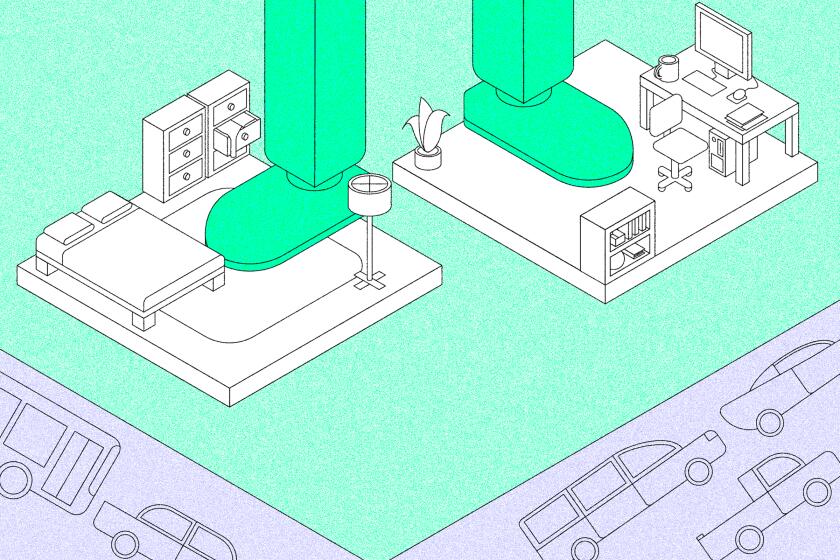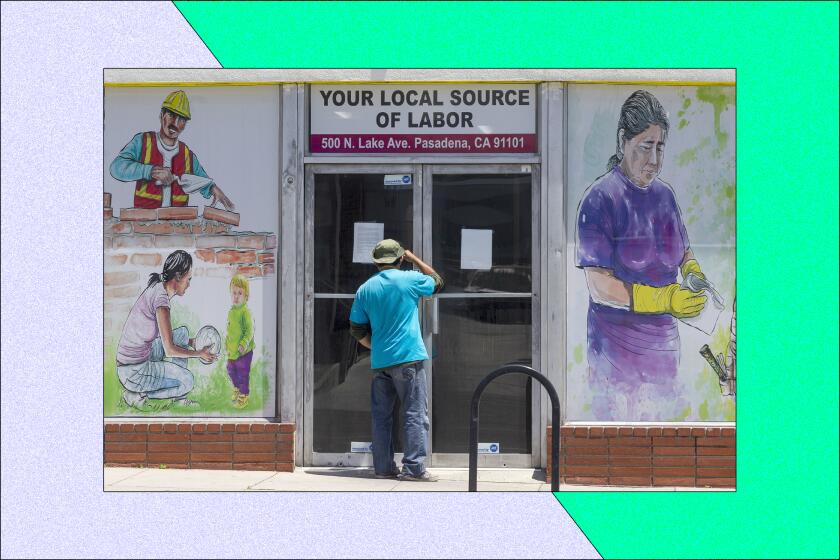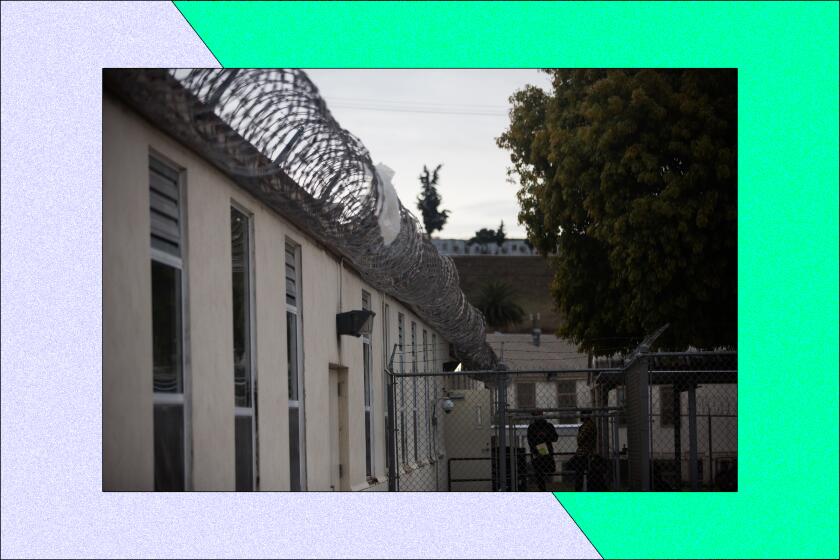Editorial: You shouldn’t need a college degree to have a decent life in America

- Share via
A young person who wants to go into hotel management typically needs a bachelor’s degree. Or at least, that’s true here. Not so in Switzerland, where a high school student would attend classes part time while also working at a paid apprenticeship for a hotel, take one more year of training after high school and be set in a well-paid career.
The University of California and California State University campuses bulge with more students each year. Meanwhile, the cost of attending college surges upward, and there is pressure in Washington to spend a trillion dollars forgiving student loan debt. High school students find their studies irrelevant and unengaging while the workplace is rife with “education inflation,” in which jobs that used to require a high school education and maybe a little bit more now require a four-year college degree.
The COVID-19 pandemic made clearer than ever the inequities in our education system, as some students learned online with the help of tutors and well-resourced parents while others lacked even reliable broadband. It laid bare the stresses of college students who couldn’t afford their tuition and of graduates without the money to pay off their college debts.
What if the problem with college education isn’t that we don’t have enough of it, but that in some ways, we have too much?
The college-for-all movement began with the worthy goal of greater educational equity — more lower-income students, more Black and Latino students, attaining the same levels of education and opportunity as white and Asian students. Not everyone, regardless of race or socioeconomics, wants or should need a four-year college degree. Education inflation not only leaves graduates (and even more, college dropouts) with crippling debt loads, but contributes to inequality and hampers the ability of many a bright student to enter the middle class.
The Swiss apprenticeship model is a particularly ripe avenue for exploration in California, which is unparalleled nationally in its public higher-education system, has many large employers in a wide range of fields, especially in technology and biotech, and where a progressive statewide culture could lend itself to broader public-private partnerships.
In order to do that, a few things would need to happen. Companies would have to stop demanding degrees that aren’t strictly necessary. They would have to participate in the training of a workforce and know that if they do, it would be far more likely to provide them with employees who have the skills they seek. And California would need to put considerable effort into improving public education for all students, making major inroads on erasing the achievement gap for Black and Latino students. The reason many employers use a college degree as a proxy for skills is that they don’t trust high schools to produce graduates who can read, do math and think.
A few years ago, intrigued by what little I’d heard about the Swiss educational system, I interviewed some parents there about their experiences for a column that appeared in the Sacramento Bee. It turns out that about 30% of Swiss students enroll in full-time, college-prep courses; they must pass a rigorous test to be accepted into the college track. Most of the rest attend high school part time and work as apprentices part time in their chosen fields. They might need an extra year or even two of schooling after high school, or might go right into full-time jobs.
Tracking is, of course, a problematic educational model in the United States, where Black and Latino students have historically been funneled into vocational rather than college-prep classes and often emerge into poorly paid fields where their skills are too easily replaced by cheaper workers overseas. But because of the more rigorous Swiss high school education and the real-life work experience they obtain, Swiss students move seamlessly into their well-paid careers of choice.
Flexibility is built into the system. Students can switch apprenticeships if they are drawn to a different career. They also can switch to college track, even after starting jobs post-graduation, by taking a one-year course of education to catch them up on college-oriented studies. By that time, many of them have gained the maturity and perspective, as well as experience using their academic skills on the job, to succeed in college — which, by the way, is tuition-free. Switzerland can afford that, by not trying to provide college for all or even most students.
The Swiss system also provides more motivation for succeeding in high school. Students see how various studies are connected with the real world. Their weeks are more varied and less tedious. And for courses where there is no obvious connection — well, they know there’s a job ahead that they will have if they put in the effort on their schoolwork.
One woman in my interviews talked about how her husband, a banking executive, had never felt the need for a college degree before he started working with American banks. He knew they would look down on his lack of formal education despite his successful longtime career. And that’s something we need to change if we want to cut back on the ever-increasing public and private cost of college education and the burden it places on students who feel they have to attend college to have a future.
A Harvard Business School report on education inflation outlines how it harms American workers as well as employers.
“Degree inflation hurts the average American’s ability to enter and stay in the workforce,” the report says. “Many middle-skills jobs synonymous with middle-class lifestyles and upward mobility — such as supervisors, support specialists, sales representatives, inspectors and testers, clerks, and secretaries and administrative assistants — are now considered hard-to-fill jobs because employers prefer candidates who are college graduates.”
It’s a bad deal for employers in the end. They pay significantly more for college graduates, the Harvard report says, and then often find that less educated workers with relevant job experience do as good a job or better, while graduates leave those jobs faster, which then requires the time and expense of hiring and training someone new. Sometimes the nature of the jobs has changed, calling for more education. But often, it’s the requirement that’s been inflated, not the work.
Education inflation exacerbates social inequity because marginalized groups, such as low-income Black and Latino students, are less likely to attend or complete college. Certainly, it’s important to make college more accessible so that all talented students have an equal shot at jobs in the professions. But to the extent that we fail to train students for good careers while they are still in high school, and require degrees that might say less about their ability to do a job than their apprenticeship experience does, we rob too many of the chance to enter fulfilling careers and the middle class.
Less than two-thirds of U.S. college students graduate within six years. Imagine the waste of educational resources, and the students’ money and time, when they come out unable to qualify for a good job or work in the field they’d chosen.
For that matter, education inflation doesn’t just affect students at this level. More jobs that used to require a bachelor’s degree now additionally require a master’s degree.
Ironically, one of the reasons for the degree inflation was that more high school students were attending college, leading employers to feel that they no longer were hiring the cream by hiring college graduates. Some of the graduate degrees indicate crucial training, such as in specific engineering or healthcare-related fields. But they have been adopted more as requirements for jobs in public policy or international relations or working in a museum and so forth.
It’s been fine for employers and terrific for universities, which fill seats and rake in more tuition money. But it’s been hard financially on students; professional degrees come with less financial aid so the net price is higher than for undergraduate school. And it cuts into their earning years.
The Swiss model might not translate perfectly to U.S. soil — a voluntary model would work better than Switzerland’s tough testing system for college-prep track, and there would have to be strict monitoring to ensure that Black and Latino students are well-represented among those headed for college — but it shows us some of what we’re missing in our educational system: Robust, quality public schools starting with preschool; a concerted effort to bring employers into the education mix; a college system that might enroll a smaller percentage of high school graduates but that grants far more of them a degree, and at low or no tuition cost; an apprenticeship system that gives high school studies more relevance and prepares students with empowering real-life skills for jobs that now require a college degree. Tech companies such as Apple already have shown themselves to be more willing to forgo a bachelor’s degree; it makes sense for a company founded by a college dropout.
If California can turn that kind of job-sector goodwill into a partnership with academic studies, at least in model programs around the state, it could narrow social inequities, excite more students about their high school studies and spend less on four-year college education while graduating just about as many students. What we’re doing now — trying to push kids into all-college-prep courses that they may not want, divorcing education from their adult futures, and raising costs — isn’t working well. Time to stop doubling down on the same model.
More to Read
A cure for the common opinion
Get thought-provoking perspectives with our weekly newsletter.
You may occasionally receive promotional content from the Los Angeles Times.



















